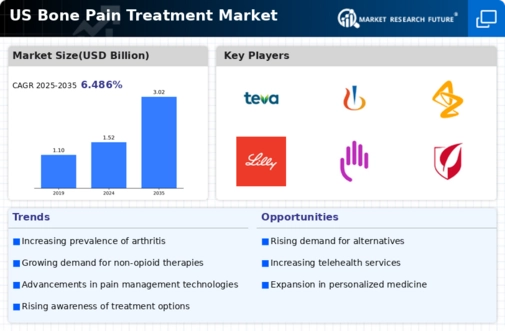The US Bone Pain Treatment Market is characterized by a dynamic and competitive landscape, driven by an increasing prevalence of bone-related disorders such as osteoporosis, arthritis, and various musculoskeletal injuries. The demand for effective therapies has simultaneously escalated the level of competition among pharmaceutical companies striving to introduce innovative treatments and capture market share. Companies are focusing on a range of strategies, including research and development initiatives to create novel drugs, partnerships with healthcare providers, and enhancing patient accessibility to existing therapies.
The market is also witnessing a surge in personalized medicine approaches and an emphasis on leveraging technology to optimize pain management. Keeping abreast of competitive positioning and market dynamics becomes crucial for stakeholders involved in the Bone Pain Treatment sector.
Teva Pharmaceutical Industries is a notable player in the US Bone Pain Treatment Market, known for its comprehensive range of generic and specialty products. The company possesses considerable strengths, including its robust product portfolio that addresses various pain conditions associated with bone disorders. Teva's established presence in the market is bolstered by its focus on affordable medication options, ensuring accessibility for patients facing bone pain issues. The company’s vast pharmaceutical capabilities also include extensive research and development capacities that allow it to innovate and improve existing treatments.
By leveraging its strong distribution network and operational efficiencies, Teva effectively caters to the diverse needs of healthcare providers and patients alike within the competitive landscape of bone pain treatment.
Novartis holds a significant position in the US Bone Pain Treatment Market with its well-regarded offerings that target bone pain management and associated conditions. The company's primary products include a range of innovative medications specifically designed for the treatment of osteoporosis and chronic pain related to bone health. Novartis's strengths lie in its commitment to research and development, which positions the company to deliver cutting-edge solutions that are both effective and tailored to the needs of patients.Furthermore, Novartis has strategically pursued partnerships and collaborations to expand its market reach and enhance its therapeutic offerings.
The company’s approach to mergers and acquisitions has also enabled it to integrate new technologies and expand its product lines, reinforcing its market presence in the competitive landscape of bone pain treatment in the US.






















